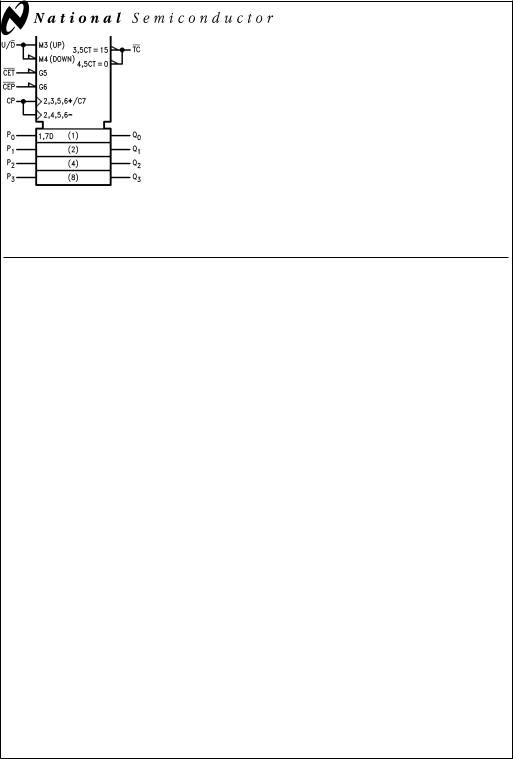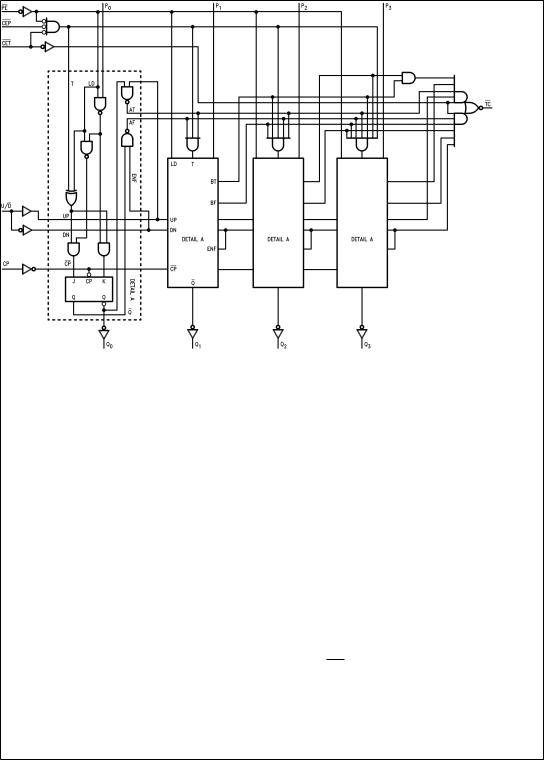NSC 5962R9160301VFA, 5962R9160301VEA, 5962R9160301V2A, 5962R9160301MFA, 5962R9160301MEA Datasheet
...
July 1998
54AC169 · 54ACT169
4-Stage Synchronous Bidirectional Counter
General Description
The 'AC/'ACT169 is fully synchronous 4-stage up/down counter. The 'AC/'ACT169 is a modulo-16 binary counter. It features a preset capability for programmable operation, carry lookahead for easy cascading and a U/D input to control the direction of counting. All state changes, whether in counting or parallel loading, are initiated by the LOW-to-HIGH transition of the Clock.
nSynchronous counting and loading
nBuilt-In lookahead carry capability
nPresettable for programmable operation
nOutputs source/sink 24 mA
n'ACT has TTL-compatible inputs
nStandard Microcircuit Drawing (SMD) 5962-91603
Features
n ICC reduced by 50%
Logic Symbols |
|
|
|
|
|
|
|
|
|
|
|
|
|
Pin |
Description |
||||||
|
|
|
Names |
|
||||||
|
|
|
|
|
|
|
|
|
|
|
|
|
|
|
|
|
|
|
Count Enable Parallel Input |
||
|
|
|
CEP |
|
||||||
|
|
|
|
|
|
|
Count Enable Trickle Input |
|||
|
|
CET |
|
|||||||
|
|
CP |
Clock Pulse Input |
|||||||
|
|
P0±P3 |
Parallel Data Inputs |
|||||||
|
|
|
|
|
|
Parallel Enable Input |
||||
|
|
PE |
|
|
||||||
|
|
|
|
|
|
Up-Down Count Control Input |
||||
|
|
U/D |
|
|||||||
DS100276-1 |
|
Q0±Q3 |
Flip-Flop Outputs |
|||||||
|
|
|
Terminal Count Output |
|||||||
|
|
TC |
|
|||||||
IEEE/IEC
DS100276-2
FACT™ is a trademark of Fairchild Semiconductor Corporation.
Counter Bidirectional Synchronous Stage-4 54ACT169 · 54AC169
© 1998 National Semiconductor Corporation |
DS100276 |
www.national.com |

Connection Diagrams
Pin Assignment |
Pin Assignment |
for DIP and Flatpak |
for LCC |
DS100276-3
DS100276-4
Logic Diagram
DS100276-5
Please note that this diagram is provided only for the understanding of logic operations and should not be used to estimate propagation delays.
Functional Description
The 'AC/'ACT169 uses edge-triggered J-K-type flip-flops and have no constraints on changing the control or data input signals in either state of the Clock. The only requirement is that the various inputs attain the desired state at least a setup time before the rising edge of the clock and remain valid for the recommended hold time thereafter. The parallel load operation takes precedence over the other operations, as indicated in the Mode Select Table. When PE is LOW, the
data on the P0±P3 inputs enters the flip-flops on the next ris- ing edge of the Clock. In order for counting to occur, both CEP and CET must be LOW and PE must be HIGH; the U/D input then determines the direction of counting. The Terminal Count (TC) output is normally HIGH and goes LOW, provided that CET is LOW, when a counter reaches zero in the Count Down mode or reaches 15 in the Count Up mode. The TC output state is not a function of the Count Enable Parallel (CEP) input level. If an illegal state occurs, the 'AC169 will return to the legitimate sequence within two counts. Since
www.national.com |
2 |

Functional Description (Continued) |
State Diagrams |
the TC signal is derived by decoding the flip-flop states, there exists the possibility of decoding spikes on TC. For this reason the use of TC as a clock signal is not recommended (see logic equations below).
1.Count Enable = CEP · CET · PE
2.Up: TC = Q0· Q1· Q 2Q3· (Up)· CET
3.Down: TC = Q0· Q1· Q2· Q3 · (Down)· CET
Mode Select Table
|
|
|
|
|
|
|
|
|
|
|
DS100276-6 |
|
PE |
|
CEP |
|
CET |
|
U/D |
|
Action on Rising |
|
|
|
|
|
|
|
|
|
|
|
|
Clock Edge |
|
|
|
|
|
|
|
|
|
|
|
|
|
|
L |
|
X |
X |
X |
Load (Pn to Qn) |
|
||||
|
H |
|
L |
L |
H |
Count Up (Increment) |
|
||||
|
H |
|
L |
L |
L |
Count Down (Decrement) |
|
||||
|
H |
|
H |
X |
X |
No Change (Hold) |
|
||||
|
H |
|
X |
H |
X |
No Change (Hold) |
|
||||
|
|
|
|
|
|
|
|
|
|
|
|
H = HIGH Voltage Level
L = LOW Voltage Level
X = Immaterial
3 |
www.national.com |
